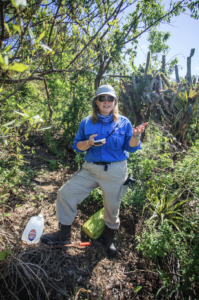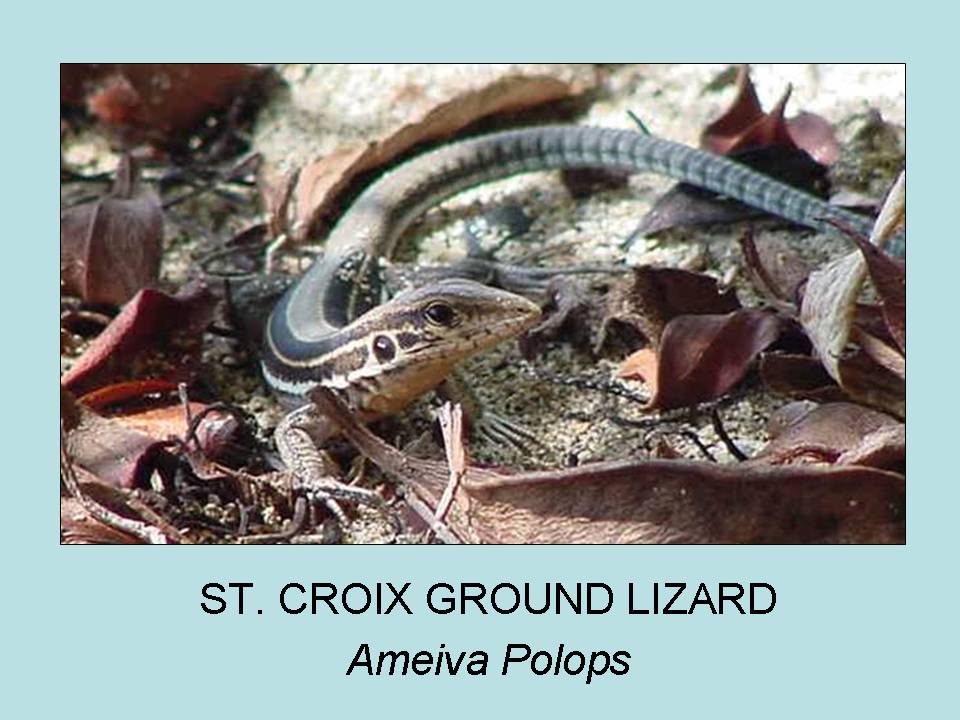(This is the last in a three-part series taking a closer look at some of the recent research projects undertaken by staff at the V.I. Department of Planning and Natural Resources Division of Fish and Wildlife.)
If the small lizard unique to the Virgin Islands makes a successful comeback, it will be due in no small part to the woman who heads up the Fish and Wildlife Division at the V.I. Department of Planning and Natural Resources and to members of her small staff.

Other entities have been involved in the years-long effort, including the National Park Service and the St. Croix Environmental Association.
But it’s V.I. Fish and Wildlife that has chased down federal funding for a reintroduction project, and its director, Nicole Angeli, who has championed the cause and joined her staff in the hands-on work to bring the indigenous animal back to the Big Island of St. Croix from surrounding cays.
She even inspired and collaborated on a children’s book, “The Lizard Lady,” by Jennifer Keats Curtis.
In a more scientific mode, Angeli was a lead author on a paper published last year by The Encyclopedia of Conservation, “Imperiled Caribbean Teiids (a type of lizard) and Conservation of the Critically Endangered St. Croix Ground Lizard.”
The work was one of eight different peer-reviewed papers published by recognized periodicals in 2022 that were co-authored by one or more staffers from Fish and Wildlife. Their subjects ranged from internal ocean tides to aquaculture, to mosses, to lizards and rodents. Angeli contributed to many of the papers.
Choosing research projects is a multi-pronged process, according to Angeli.
Fish and Wildlife is an unusual agency in that it is funded solely by the federal government but is administered under the Virgin Islands DPNR. That hybrid status has it considering the priorities of both the local and federal government when it comes to choosing projects for research. It also has some ideas of its own.
The available (human) resources are often key to determining research subjects.
“We have a special privilege here,” Angeli said, in the form of a hard-working and academically diverse staff. For example, Maggie Motiani is a fisheries biologist specializing in shark ecology; wildlife biologist Sean Kelly has considerable experience studying spiders that fish in freshwater ecosystems; Fisheries Director Sennai Habtes is an expert in ocean currents; and Jahnyah Brooks is a wildlife biologist with a background in plant ecology.
“That’s why it’s exciting to work here,” Angeli said. There are highly educated people with a wide range of expertise.
While the local government provides no funding for the work, sometimes Angeli and her staff are able to fit the desires of the local community into federal initiatives and thus secure federal grant money for a particular program.
The St. Croix ground lizard was a perfect fit for local interest with federal funding as well as staff experience. The lizard is on the national Endangered Species list; it’s special to the island community, and Angeli already had studied some of its cousins.

The reptile was once a common site on St. Croix before humans turned much of its woodsy, natural habitat into farmland and introduced the mongoose, an invasive animal that turned into a major predator of the ground lizard.
The lizards, of course, are predators too. They eat a large quantity of small insects. That can be beneficial to people since they keep some pests in check. Because they burrow in the ground, they also aerate the soil naturally, which is a boon for farmers.
“It’s a huge service,” Angeli said.
As early as the 1930s, it was becoming apparent that the St. Croix ground lizard was on the decline, she said. Some of the insects that they kept in check, specifically grubs and centipedes, were growing into massive populations in areas that had become inhospitable to the lizards. In the past 50 years, the animals have disappeared from the more populous Big Island and are found only on a few outlying islands that are un- or sparsely inhabited.
For a decade or more, there has been talk among environmentalists about the possibility of “repatriating” the St. Croix ground lizard from the cays back to the main island. It sounds simple. But there are few considerations.
For one thing, you have to catch them first.
The animal is so small that its body, excluding the tail, can fit in the palm of a human hand. It’s predominately black, white and light brown, with stripes running down its back to a tail of blue and black rings, making it hard to see in the brush.
“They’re very difficult to catch,” Angeli said. “It can take me about an hour to catch a lizard once I spot it.”
In 2022, with the help of volunteers, the division caught lizards on Buck Island and transported them to St. Croix, leaving 10 at one site and nine at another, and making sure to maintain a ratio of about three females per male to promote reproduction.
Then there’s the problem of the animal’s homing instinct. Angeli said that scientists have learned from in-depth studies of some 250 re-introduction projects of various species throughout the world that it is very important to take that instinct into consideration.
Like a relocated housecat that finds its way back to its owner’s former house, or an immigrant who longs for his homeland, the little lizards were likely to try to get back to Buck Island. Besides, they hunt for food. “It’s difficult to keep lizards where you want them,” she said.
So, the researchers placed them in an enclosed space and monitored them for six months. Chicken wire kept mongoose out and plastic siding kept the lizards in. Eventually, though, the lizards worked their way out, but not before a juvenile was spotted in the enclosure at Sandy Point — an encouraging sign that the group was establishing a colony.
Now, “We think they’re in the forest” near the spots where they were resettled, Angeli said.
Plans call for a second relocation to occur in February of 2024, she said. Once all the equipment and the staff and volunteers are set up, it will take about three or four days.
Meanwhile, Angeli has been working on other projects. She said two of them are getting close to concluding. One will be a report on the mongoose population at Sandy Point, for which she’s combing through historical data going back 12 years.
The other is a report on the Virgin Islands tree boa — not to be confused with the red-tail boa. The latter is a popular exotic pet that researchers believe was introduced to St. Croix when an owner released one or more into the wild and which is an unwelcome invasive species. In contrast, the tree boa is indigenous and endangered. Fish and Wildlife has been monitoring tree boas on a cay off of St. Thomas, tagging them and collecting data for six years.
Despite the large number of research projects she has led or contributed to, Angeli said that actually, “very little” of her day job is research-based.
As director of the division, her work is far more administrative. She’s responsible for things like staffing, ensuring equipment is available and functional, finding and applying for grants and other funding, record-keeping and other managerial tasks.
For the most part, “I’m doing it (research) on my own time,” she said, adding, “It’s the thing that I like.”
If you missed the previous two articles in this series, find them in the links below.
Part One: Academics in the Wild: Native Son Gets Up Close With ‘Other’ V.I. Populations





